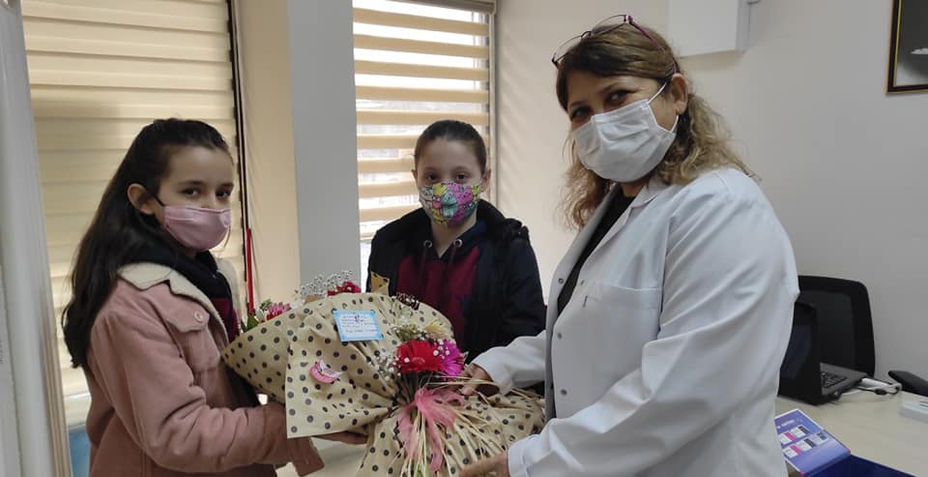
The Future Is Now

eTwinning 2021



The world is a magnificent and unique place.At least nine million different species are thought to inhabit here, from animals and plants to algae, fungi, bacteria and other smaller creatures.But the people are the only creatures who changed the fate of all these riches.The growing population is putting increasing pressure on the rest of nature, and the real problem lies in the way people behave towards nature.
We say that everything we can't do forever is unsustainable.This includes using fossil fuels to generate energy,catching more fish than would naturally reproduce from the ocean, draining wetlands and cutting down forests to make farmland.
Climate change is a long-term change in weather patterns, mostly caused by human activity, including rising average temperatures around the world.
Farming, cutting down forests, burning fossil fuels are some of the activities that cause warming of the oceans, melting of ice in the poles and mountains, and changing the annual cycles of the seasons.
I'm a paragraph. Click here to add your own text and edit me. It’s easy.


Earth is a comfortable place for living things.It has the right temperatures for plants and animals-including humans-to thrive.
Why is Earth so special?
One reason is :
GREENHOUSE EFFECT!!
A greenhouse is a building with glass walls and a glass roof.The clear glass allows sunlight to shine into the greenhouse,while also trapping the Sun's heat inside.This is how a greenhouse keeps plants warm even at night and in the winter.
The greenhouse effect keeps Earth warm in pretty much the same way.Earth is not surrounded by glass but it is surrounded by a jacket of gases called atmosphere.In the daytime the sun shines through the atmosphere warming Earth's surface.After the Sun goes down,Earth's surface cools.This releases heat back into the air.But some of that heat is trapped by the gases in the atmosphere.These heat-trapping gases are called greenhouse gases.
The main greenhouse gases are:
-
Water vapor
-
Carbon dioxide
-
Methane
-
Ozone
-
Nitrous oxide
-
Chlorofluorocarbons
Earth needs a balance of greenhouse gases to maintain just the right temperature for living things.But some human activities are changing Earth's natural greenhouse effect.
I'm a paragraph. Click here to add your own text and edit me. It’s easy.
OUR lessonS



Our Team Photo



Our ChatroomActivity
TEAM 1 COMMON WORKS
Climate Change Photos
.png)
Climate Change Comics
.png)
How Green Are You?
Team 1 Activities





What are the causes and effects of water pollution?
Waste tips, deforestation, pesticides used in farming, sewage… the causes of water pollution are diverse and all the result of human intervention. What are the main consequences of water pollution? Firstly, the disappearance of biodiversity and aquatic ecosystems. Also, humans are harmed by the alteration in the food chain and by contracting illnesses when drinking or using contaminated water. As you can see, water pollution has a great impact in the environment. Let's watch a video about the topic and then use quizlet to learn new words on the topic.
I'm a paragraph. Click here to add your own text and edit me. It’s easy.



-
Topic: POLLUTION
-
Subtopic: HOW BIG IS YOUR CARBON FOOTPRINTThe size of your carbon footprint indicates how much impact you have on the environment.
In the past 100 years or so, humankind has created machines, factories, and vehicles that have greatly increased the amount of greenhouse gases in our atmosphere. This increased level of greenhouse gases means more heat is held in the atmosphere and the Earth is getting warmer. These warmer temperatures are causing changes around the world on land, in the oceans, and in the air. This could upset the delicate balance that sustains life.
Whether we realize it or not, we all emit carbon dioxide, one of the greenhouse gases, through our day-to-day activities. The amount we emit is referred to as our “carbon footprint.” The bigger the footprint, the more carbon dioxide that comes from each of us as a result of the choices we make.
Climate change caused by excess greenhouse gases and a big carbon footprint can cause:
• Heat waves that damage crops, stress livestock, and make life difficult for people.
• More air pollution, which is linked to allergies, asthma, and other health problems.
• Severe storms and flooding due to higher sea levels.
• Loss of habitat as the climate changes, particularly in Arctic regions.
Families can help reduce their carbon footprint by focusing on four major areas that generate excess carbon dioxide: housing and household energy use, transportation, personal habits, and recycling.
Can you please go to this link, and calculate your Carbon Footprint:
-
-
-
I'm a paragraph. Click here to add your own text and edit me. It’s easy.

our recyclıng works


Team Students' Bookmarks on How
to Prevent Pollution


POLLUTION TEAM COMMON WORK by Ali Mentor & Team Students



Brainstorming on Overhunting
Let's Learn The New Words!
-
Topic: OVERHUNTING
-
Overhunting is an activity that results in a serious reduction of species population or harm to wildlife. It is otherwise defined as the relentless chase for wild or game animals to kill or catch them for economic or personal gains or food.
-
In several parts of the world, people continue to depend on wildlife for many needs, and it is the act of killing, capturing or hunting down more animals than their populations can supply that contributes to overhunting.
-
In simple terms, overhunting could easily be called overexploitation of natural resources. It is a crime against that ought to be stopped without any further delay whatsoever. It is not just a threat to the survival of wildlife, but it is also a threat to the survival of life as a whole on this planet.
-
-
-
-
I'm a paragraph. Click here to add your own text and edit me. It’s easy.
Preparations for Final Common Work!

The Future Is Now Rap Challenge by Dilek mentor & Team 3 Students

Let's learn new vocabularies!
Despite the harmful effects caused by this activity, millions of people across the world, still continue to capture, kill, or hunt down the animal population for their selfish needs and benefits.
Here you can see Some Causes of Overhunting:
-
Overpopulation
-
Cosmetic Products
-
Growing Demand For Food
-
Tradition and Culture
-
Fun or Sport
-
Fur, Decoration and Other Economic Values
-
Manufacture of Medicines
I'm a paragraph. Click here to add your own text and edit me. It’s easy.
IF WE GET RID OF OVERHUNTING, THE WORLD WILL BE A BETTER PLACE
-
It will help preserve ecosystems
-
It will preserve diversity
-
It will maintain the beauty of the planet
-
It will help maintain culture
The world is in human beings’ hand. Of course we can put an end to overhunting. But how? What can we do stop this global problem?


Preparations for Common Work & Exhibition
Our Padlet with Logos,Slogans & Posters
.png)

OUR COMMON MOSAIC
OVERHUNTING VIRTUAL EXHIBITION BY FATMA MENTOR & TEAM 3 STUDENTS

I joined the project as one of the vital topics today in the Pandemic times is to focus on Problem Soling Activities and Social Emotional Learning is one of them. SEL is the process of developing the self-awareness, self-control, and interpersonal skills that are vital for school, work, and life success.
SEL is an integral part of education and human development as a process through which all young people acquire and apply the knowledge, skills, and attitudes to develop healthy identities, manage emotions and achieve personal and collective goals, feel and show empathy for others, establish and maintain supportive relationships, and make responsible and caring decisions. (CASEL)




Health issue occurs when the normal metabolism of the body failed or altered due to pollutant, pathogen or other means that cause health problem which are considered as disease.
Sometimes these issues could be genetic, in which the patient might inherit the disease causing gene from their parents. These health issues were first diagnosed and an effective treatment is given to the patient depending on his need so that the body metabolism returns back to normal. Thus helps the patient to recover from the disease.
There are four main types of disease: infectious diseases, deficiency diseases, hereditary diseases (including both genetic diseases and non-genetic hereditary diseases), and physiological diseases.
Our Task Document
Making Videos Document
World Health Day Idioms Book prepared by Hatice mentor and all project students.
Diseases Role Plays Common Work by Hatice Mentor & Team Students
World Health & Water Day Dissemination Activities by Hatice Mentor & Team Students

World Health Day Activities by Aleksandra Mentor & Team Students

WHAT IS MISINFORMATION?
Misinformation is “false information that is spread, regardless of intent to mislead.”
The spread of misinformation happens often in our everyday lives. We human beings—news flash—are not perfect. We can all make mistakes. We all forget things. We mishear or misremember details. We tell our friends something we heard on TV or saw on social media that wasn’t really true. If you are spreading around information that is wrong but you don’t know it is wrong, then you are, well, technically, spreading misinformation.
And when we say misinformation is an everyday thing, we mean it. For example, say a party starts at 8pm, but you forget or misread the invitation and tell your friends it starts at 9pm, you are supplying them with misinformation. But don’t fear: we’re not calling the fact police on you! The key, here, is that you unwittingly spread false information around; you didn’t mean to, or even might have thought the information was true.
Misinformation doesn’t care about intent, and so is simply a term for any kind of wrong or false information.
Today, misinformation spreads very easily thanks to technology. On social media, users have—as just one tiny instance—shared stories about dolphins and swans swimming in the canals of Venice without checking if those stories are true (they weren’t).
-
Disinformation: Information that is false and deliberately created to harm a person, social group, organisation or country
-
Misinformation: Information that is false but not created with the intention of causing harm
TermDefinitionSource
misinformation
“false information that is spread, regardless of whether there is intent to mislead.”
Dictionary.comdisinformation
“deliberately misleading or biased information; manipulated narrative or facts; propaganda.”
Dictionary.comfake news
"purposefully crafted, sensational, emotionally charged, misleading or totally fabricated information that mimics the form of mainstream news"
Fake News: understanding media and misinformation in the digital age
FACT or FAKE??
We should add fake news or fact (true news) on the padlet. Then other students will try to understand if it is fake or not. Finally they should comment under the news,FAKE or FACT...We should search for the news everytime to understand the misinformation, disinformation and fake news.

Fake or Fact ? Padlet Activities by Nihal Mentor & Team Students
.png)

























































